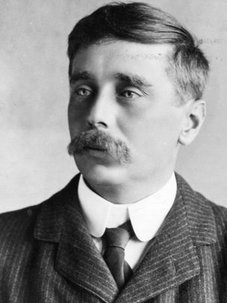H.G. Wells, Clairvoyant?
 One part of my self-assigned post-retirement reading lists consists of the best science fiction novels of the 20th-century. H.G. Wells’s four best-known novels were written near the end of the 19th-century (1895-1898). He along with Jules Verne defined the genre and, though their seminal works fall outside the timeframe of my survey, I included them in an addendum to my list. As a relative newcomer to sci-fi I felt compelled to sample the creations of its founding fathers.[1]
One part of my self-assigned post-retirement reading lists consists of the best science fiction novels of the 20th-century. H.G. Wells’s four best-known novels were written near the end of the 19th-century (1895-1898). He along with Jules Verne defined the genre and, though their seminal works fall outside the timeframe of my survey, I included them in an addendum to my list. As a relative newcomer to sci-fi I felt compelled to sample the creations of its founding fathers.[1]
Wells has been widely credited with anticipating the future in his series of science fiction novels. He was one of eight sci-fi writers featured in Ridley Scott’s Science Channel series Prophets of Science Fiction.[2]
Was Wells clairvoyant? Well, not really. A lot of what he wrote comes across as downright ridiculous today. (It is easy to chuckle at the ignorance of our ancestors, isn’t it? Thank a scientist.) Much of what he speculated about, though, still fascinates us. Some of it is more or less true today.
Here are my jumbled thoughts on each of these four novels. I have listed them in the order I read them, as if that is somehow important.
The Invisible Man (1897)
 An optician figures out how to change the “refractive index” of a living animal. First a cat and, later, himself. Unfortunately he fails in his attempts to reverse the process. So he wraps himself in a hooded cloak, covers his face with bandages, and wears a fake pink nose. (He was several decades too soon to make use of the classic Groucho Marx nose, glasses and mustache ensemble.) Disguised and a true Englishman, he sits down at a pub for a pint of ale. Things take a violent and tragic turn.
An optician figures out how to change the “refractive index” of a living animal. First a cat and, later, himself. Unfortunately he fails in his attempts to reverse the process. So he wraps himself in a hooded cloak, covers his face with bandages, and wears a fake pink nose. (He was several decades too soon to make use of the classic Groucho Marx nose, glasses and mustache ensemble.) Disguised and a true Englishman, he sits down at a pub for a pint of ale. Things take a violent and tragic turn.
As Time Magazine reported this year, invisibility cloaks may be coming to a T.J. Maxx near you soon. This technology will be a far cry from Wells’s conception, however. Apparently it will be easier to make invisible clothes than invisible humans.
The Island of Doctor Moreau (1896)
 This creepiest of Wells’s novels[3] was written at a time of growing anti-vivisectionist feeling in Britain. Then, as now, cruelty to animals was the primary concern. But the specter of human/animal hybrids was taken seriously as a threat to our species.
This creepiest of Wells’s novels[3] was written at a time of growing anti-vivisectionist feeling in Britain. Then, as now, cruelty to animals was the primary concern. But the specter of human/animal hybrids was taken seriously as a threat to our species.
The story is a predictable one: things do not end well for Doctor Moreau. A hungry puma does him in. His assistant, a man named Montgomery, makes a critical mistake when he chooses to share alcohol with several beast-men around a campfire. The castaway who chances to witness all of this is lucky to escape the island with his life.
Nowadays we are used to the idea of animal organs transplanted into humans. We don’t worry much about the crude methods described in the book, but we do have reason to be concerned about our powerful abilities in the field of genetic engineering.
The Time Machine (1895)
 Thanks to crossword puzzles this book will never be forgotten. The gentle, soft-as-soap humans living above ground are called “Eloi,” and that combination of letters is an irresistible draw for crossword makers. In the future, Eloi themselves will be an irresistible draw for underground-dwelling Morlocks. Wells doesn’t say it explicitly, but I’m pretty sure they taste like chicken.
Thanks to crossword puzzles this book will never be forgotten. The gentle, soft-as-soap humans living above ground are called “Eloi,” and that combination of letters is an irresistible draw for crossword makers. In the future, Eloi themselves will be an irresistible draw for underground-dwelling Morlocks. Wells doesn’t say it explicitly, but I’m pretty sure they taste like chicken.
The concept of time travel was not unheard of at the time, of course, but apparently Wells coined the term “time machine.” His contraption seems laughably quaint today, but with a bit of imagination and a willful suspension of disbelief, it seems as plausible as either the DeLorean used in the Back to the Future films or Doctor Who’s TARDIS.
What is more interesting than the mode of travel is Wells’s speculation about the evolutionary changes wrought in humans over the 800,000-year timespan traveled by the unnamed narrator.
If time travel is possible it is still a very long ways away. See physics.org’s “Is Time Travel Possible?”.
The War of the Worlds (1898)
 We have all seen innumerable photographs of the surface of Mars. We don’t worry so much anymore about an attack from that quarter. Things were very different in 1898. Thanks to Giovanni Schiaparelli, Percival Lowell and others there was in fact a very widespread belief that intelligent life existed on Mars. A civilization capable of constructing a a planet-wide canal system.
We have all seen innumerable photographs of the surface of Mars. We don’t worry so much anymore about an attack from that quarter. Things were very different in 1898. Thanks to Giovanni Schiaparelli, Percival Lowell and others there was in fact a very widespread belief that intelligent life existed on Mars. A civilization capable of constructing a a planet-wide canal system.
As anyone who watched Matt Damon in this year’s The Martian can attest, the Red Planet is as bereft of intelligent life as any gathering of Tea Party loyalists.
Rocket pioneer Robert Goddard credited this novel with inspiring his work.
—
Notes
- More than 30 years ago I read Jules Verne’s 20,000 Leagues under the Sea and at least two of Wells’s novels . They are generally considered to be the pioneers of science fiction, though some consider Mary Wollstonecraft Shelley’s Frankenstein to be the very first sci-fi novel. It was published in 1818! [^]
- The other authors portrayed in the series were Mary Shelley, Philip K Dick, Arthur C Clarke, Isaac Asimov, Jules Verne, Robert Heinlein, and George Lucas. [^]
- Creepiest of the four novels mentioned here. I can’t say anything about the 30 or more of his novels I have not read. [^]
| DATE | TITLE |
| 12/09/2019 | Books 2019: #2 Dozen Really Matter? |
| 05/20/2019 | Why Not Both? |
| 04/23/2019 | Books 2019: #1 Take Ten |
| 04/15/2019 | Books 2018: #31 - #37 |
| see also ... | 113 Great 20th Century Novels |
| 46 Great 20th Century Crime Novels | |
| 45+ Great 20th Century SciFi/Fantasy Novels | |
| Books Read (2008-) | |
| Index of Book Posts |
